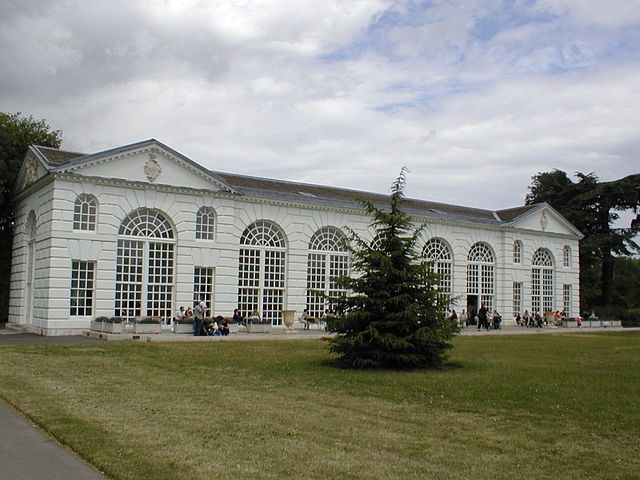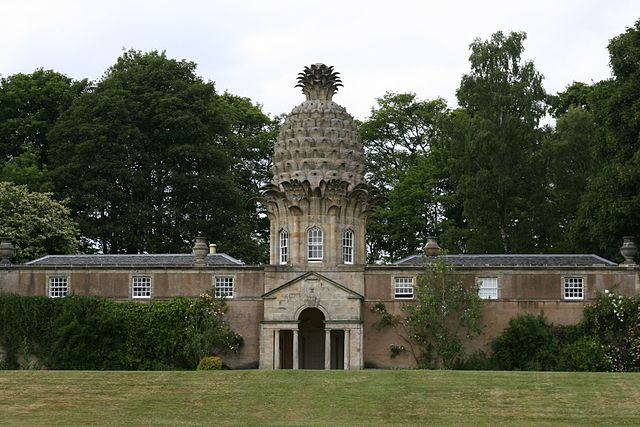With a candlestick in the conservatory
I'd been looking all over for someplace for my hero Ash and my heroine Lydia to have sex. They're in a betrothal of convenience so they can be alone together without a chaperone, but: it's wintertime, cold and wet outside; Ash is staying at an inn where she would be recognized; and Lydia's family home is huge but filled with windows and it's unpredictable when a servant might pop in or a gardener or visitor wander by outside.
Then, in an unrelated conversation, Ash (who grew up very poor) asked if Lydia's house had an orangery like he's heard about. And it hit me: the conservatory would be warm, and in the evening there wouldn't be anyone there. Could this be the place?
I did some research, online and at the library. I highly recommend the book Glass Houses: A History of Greenhouses, Orangeries, and Conservatories by May Woods and Arete Swartz Warren. I discovered a few things that surprised me (having known absolutely nothing about the topic previously).
The building I was thinking of would almost exclusively be called a "greenhouse" until the early nineteenth century (including some buildings, like the Orangery at Kensington Palace, that were referred to as orangeries in the Victorian period and still are). "Orangery" had not yet generalized from referring only to orange trees and usually meant an outside area where the orange trees were placed in summer, although it could also refer to a minimally heated building where they were moved in winter to keep them from freezing. A building that was for tropical plants generally would be a greenhouse, although it usually included orange, lemon, and lime trees in wintertime. Other popular plants included gardenias, jasmine, camellias (although those didn't reach the height of their popularity until the 1840s), agaves (then called American aloes), and myrtles.
Greenhouses were only kept at between 40 and 50 degrees Fahrenheit, as being the temperature appropriate for wintering citrus trees. In fact, the entire functionality of greenhouses was a little different than I had expected, which leads to...
Greenhouses were not built with glass roofs until the early nineteenth century. The change happened both because the technology necessary for cast-iron-and-glass construction was developed, and because a much greater variety of tropical plants were being brought to England, such as orchids, which then needed to be displayed. In the Regency era, older greenhouses might have their roofs replaced with glass ones, or might be rebuilt in the new way. But it was also perfectly possible that a greenhouse belonging to a family that wasn't especially interested in exotic plants would still be in the older style.
In the late eighteenth century, the commonest form of greenhouse was a long, narrow neoclassical stone building on the grounds, sometimes near the main house or attached to one of the wings, but often not. (They could also be made of wood if money and labor were an issue, but it was less desirable because less permanent and less heat-retaining.) It had a peaked roof and tall windows with heavy shutters on the south wall only (and occasionally one or two on the narrow western wall).
During the day, the shutters would be opened to let in the light, then closed again at night (incidentally providing plenty of privacy for Ash and Lydia!). In the summertime, the windows themselves would be thrown open during the day to let in air for the plants that were too delicate or too stationary (e.g. a vine growing over a wall) to be moved entirely outdoors.
The building was heated by stoves below the floor whose smoke was then piped through the northern stone wall with flues that were as close to horizontal as possible. Anything that needed a warmer temperature or any fruits and vegetables that were to be forced out of season were kept in practical and unornamental forcing houses (sometimes called stoves) out of sight, usually near the kitchen gardens. These forcing houses were much smaller and often did have glass roofs.
An exception to this rule is the Dunmore Pineapple, built for the Earl of Dunmore in 1761 in Stirlingshire, Scotland.
There were also vineries, which varied in shape but were built specifically for, you guessed it, vines, often grapes. The vinery at Hampton Court still has a Black Hamburg grape vine planted in 1768 by Capability Brown (okay, he probably didn't actually plant it himself, but)--the vinery itself, though, has been replaced many times.
For more photos of late Georgian greenhouses, including a great one of the unrestored interior of one, check out my Pinterest board for Crimson Joy reference images. You can see the oldest extant cast-iron-and-glass greenhouse in England, built at Chiselhampton at the turn of the century, here. I'm afraid it's not a great picture but you can see the general shape.
For a detailed and readable primary source on the varieties of available plants and their care, I highly recommend John Claudius Loudon's Encyclopedia of Gardening, 1824 (link goes to Google books).
Then, in an unrelated conversation, Ash (who grew up very poor) asked if Lydia's house had an orangery like he's heard about. And it hit me: the conservatory would be warm, and in the evening there wouldn't be anyone there. Could this be the place?
I did some research, online and at the library. I highly recommend the book Glass Houses: A History of Greenhouses, Orangeries, and Conservatories by May Woods and Arete Swartz Warren. I discovered a few things that surprised me (having known absolutely nothing about the topic previously).
The building I was thinking of would almost exclusively be called a "greenhouse" until the early nineteenth century (including some buildings, like the Orangery at Kensington Palace, that were referred to as orangeries in the Victorian period and still are). "Orangery" had not yet generalized from referring only to orange trees and usually meant an outside area where the orange trees were placed in summer, although it could also refer to a minimally heated building where they were moved in winter to keep them from freezing. A building that was for tropical plants generally would be a greenhouse, although it usually included orange, lemon, and lime trees in wintertime. Other popular plants included gardenias, jasmine, camellias (although those didn't reach the height of their popularity until the 1840s), agaves (then called American aloes), and myrtles.
Greenhouses were only kept at between 40 and 50 degrees Fahrenheit, as being the temperature appropriate for wintering citrus trees. In fact, the entire functionality of greenhouses was a little different than I had expected, which leads to...
Greenhouses were not built with glass roofs until the early nineteenth century. The change happened both because the technology necessary for cast-iron-and-glass construction was developed, and because a much greater variety of tropical plants were being brought to England, such as orchids, which then needed to be displayed. In the Regency era, older greenhouses might have their roofs replaced with glass ones, or might be rebuilt in the new way. But it was also perfectly possible that a greenhouse belonging to a family that wasn't especially interested in exotic plants would still be in the older style.
In the late eighteenth century, the commonest form of greenhouse was a long, narrow neoclassical stone building on the grounds, sometimes near the main house or attached to one of the wings, but often not. (They could also be made of wood if money and labor were an issue, but it was less desirable because less permanent and less heat-retaining.) It had a peaked roof and tall windows with heavy shutters on the south wall only (and occasionally one or two on the narrow western wall).
 |
| The orangery at Kew Gardens, built in 1761, shows the typical shape. Photo via Wikimedia Commons. |
During the day, the shutters would be opened to let in the light, then closed again at night (incidentally providing plenty of privacy for Ash and Lydia!). In the summertime, the windows themselves would be thrown open during the day to let in air for the plants that were too delicate or too stationary (e.g. a vine growing over a wall) to be moved entirely outdoors.
.jpg/640px-The_Orangery_(7279974044).jpg) |
| Photo by xlibber, via Wikimedia Commons. Here you can see the orange trees in decorative tubs have been moved outdoors in summer. |
The building was heated by stoves below the floor whose smoke was then piped through the northern stone wall with flues that were as close to horizontal as possible. Anything that needed a warmer temperature or any fruits and vegetables that were to be forced out of season were kept in practical and unornamental forcing houses (sometimes called stoves) out of sight, usually near the kitchen gardens. These forcing houses were much smaller and often did have glass roofs.
An exception to this rule is the Dunmore Pineapple, built for the Earl of Dunmore in 1761 in Stirlingshire, Scotland.
 |
| Photo via Wikimedia Commons. The pineapples would have been kept in the peak-roofed wings to either side; the central pineapple-shaped part was for recreational use. Originally, there were also glass houses for peaches, melons, cherries, and strawberries that stretched on either side of the stone building. |
 |
| "The Vinery," by Thomas Rowlandson, via Wikimedia Commons. Undated, can anyone hazard a guess based on the clothes? |
For more photos of late Georgian greenhouses, including a great one of the unrestored interior of one, check out my Pinterest board for Crimson Joy reference images. You can see the oldest extant cast-iron-and-glass greenhouse in England, built at Chiselhampton at the turn of the century, here. I'm afraid it's not a great picture but you can see the general shape.
For a detailed and readable primary source on the varieties of available plants and their care, I highly recommend John Claudius Loudon's Encyclopedia of Gardening, 1824 (link goes to Google books).



Comments
Post a Comment